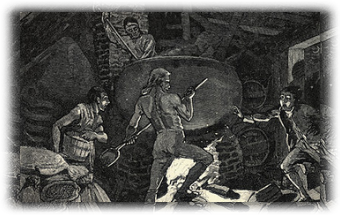|
A Sound
in the Wilderness
 The
whiskey barrel on the South Hills
Squadron's burgee recalls the Western
Pennsylvania Whiskey Rebellion. The
first squadron meetings were held in the
Pioneer Inn, one of the spots where the
tax protests and the rebellion
germinated. The
whiskey barrel on the South Hills
Squadron's burgee recalls the Western
Pennsylvania Whiskey Rebellion. The
first squadron meetings were held in the
Pioneer Inn, one of the spots where the
tax protests and the rebellion
germinated.
The Allegheny
Mountains were a formidable barrier to
horse drawn shipments to the eastern
markets, so farmers distilled their
grain. Converted into whiskey, the grain
went to market as "Old Monongahela Rye"
which sold for 25 cents a gallon and
brought twice the price in eastern
markets. "Wet goods" was often bartered
for "dry goods" because little hand
money was seen in those times.
Secretary Hamilton's
tax on whiskey in 1791 was a big burden
on the farmers who thought the tax
discriminatory. By 1794 the "Whiskey
Boys" were in open rebellion. They
tarred and feathered tax collectors and
even marched on Pittsburgh. President
Washington sent 13,000 man militia
against the 250 rebels who were
squashed, but not before the insurgents
had staunchly stood for their rights
against the tax.
There were
skirmishes, vandalism and house
burnings. On July 16, 1794, tax
collector General John Neville's mansion
and barn on Bower Hill Road were burned.
The muster at Braddock's field and march
on Pittsburgh were considered treason
and a few of the "insurrectionists" were
taken east for trial. They were
subsequently pardoned. The excise tax
was later repealed in 1800.
The swift crushing of
the Whiskey Rebellion showed the
citizens not only that their new
government was strong and could make
them obey its laws, but also that it was
just and could listen to the voice of
the people.
South Hills
Squadron's burgee preserves this
important bit of American history.
|